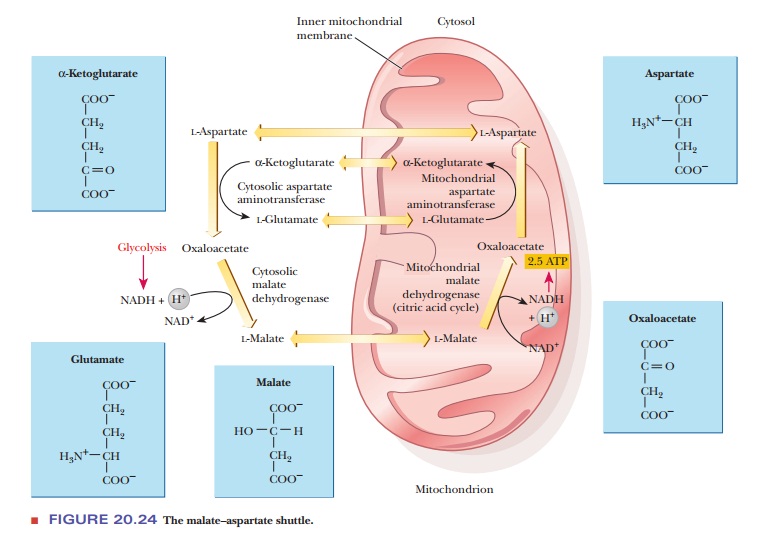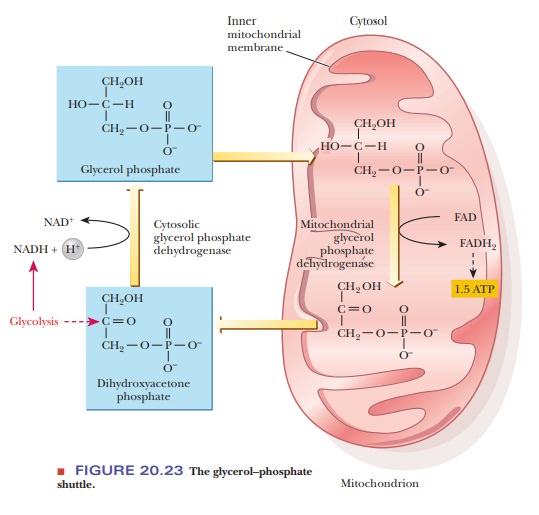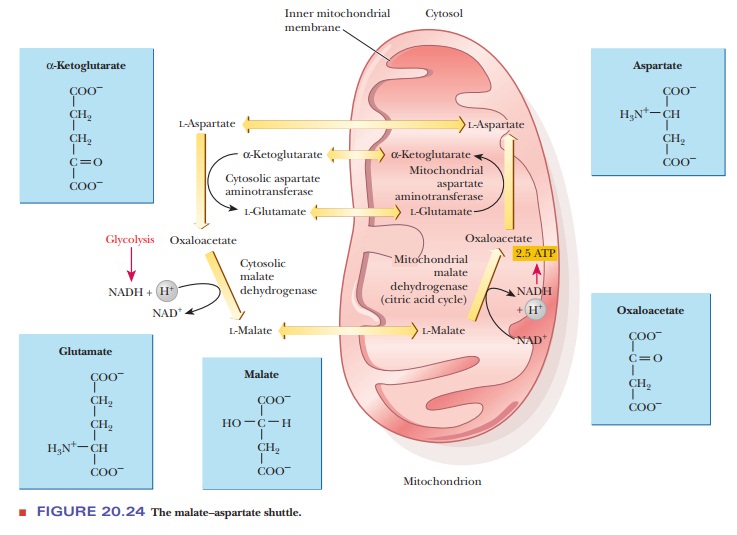Chapter: Biochemistry: Electron Transport and Oxidative Phosphorylation
Shuttle Mechanisms

Shuttle Mechanisms
NADH is produced by glycolysis, which occurs in the cytosol, but
NADH in the cytosol cannot cross the inner mitochondrial membrane to enter the
electron transport chain. However, the electrons can be transferred to a
carrier that can cross the membrane. The number of ATP molecules generated
depends on the nature of the carrier, which varies according to the type of
cell in which it occurs.
How do shuttle mechanisms differ from one another?
One carrier system that has been extensively studied in insect flight muscle is the glycerol–phosphate shuttle. This mechanism uses the presence on the outer face of the inner mitochondrial membrane of an FAD-dependent enzyme that oxidizes glycerol phosphate.
The glycerol phosphate is produced by the
reduction of dihydroxyacetone phosphate; in the course of the reaction, NADH is
oxidized to NAD+. In this reaction, the oxidizing agent (which is
itself reduced) is FAD, and the product is FADH2 (Figure 20.23). The
FADH2 then passes electrons through the electron transport chain,
leading to the production of 1.5 moles of ATP for each mole of cytosolic NADH.
This mechanism has also been observed in mammalian muscle and brain.

A more
complex and more efficient shuttle mechanism is the malate–aspartateshuttle, which has been found in mammalian kidney,
liver, and heart. Thisshuttle uses the fact that malate can cross the
mitochondrial membrane, while oxaloacetate cannot. The noteworthy point about
this shuttle mechanism is that the transfer of electrons from NADH in the
cytosol produces NADH in the mitochondrion. In the cytosol, oxaloacetate is
reduced to malate by the cyto-solic malate dehydrogenase, accompanied by the
oxidation of cytosolic NADH to NAD+ (Figure 20.24). The malate then
crosses the mitochondrial mem-brane. In the mitochondrion, the conversion of
malate back to oxaloacetate is catalyzed by the mitochondrial malate
dehydrogenase (one of the enzymes of the citric acid cycle). Oxaloacetate is
converted to aspartate, which can also cross the mitochondrial membrane.
Aspartate is converted to oxaloacetate in the cytosol, completing the cycle of
reactions.

The NADH that is produced in the mitochondrion thus passes electrons to the electron transport chain. With the malate–aspartate shuttle, 2.5 moles of ATP are produced for each mole of cytosolic NADH rather than 1.5 moles of ATP in the glycerol–phosphate shuttle, which uses FADH2 as a carrier.
Summary
Shuttle mechanisms transfer electrons, but not NADH, from the
cytosol across the mitochondrial membrane.
In the malate–aspartate shuttle, 2.5 molecules of ATP are produced
for each molecule of cytosolic NADH, rather than 1.5 ATP in the glycerol–
phosphate shuttle, a point that affects the overall yield of ATP in these
tissues.
Related Topics